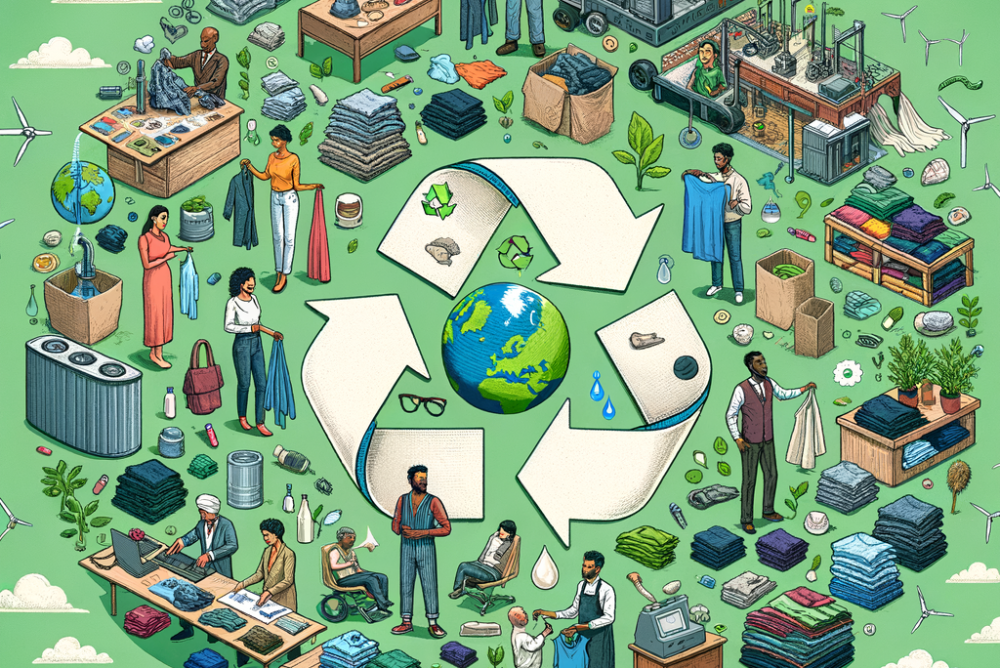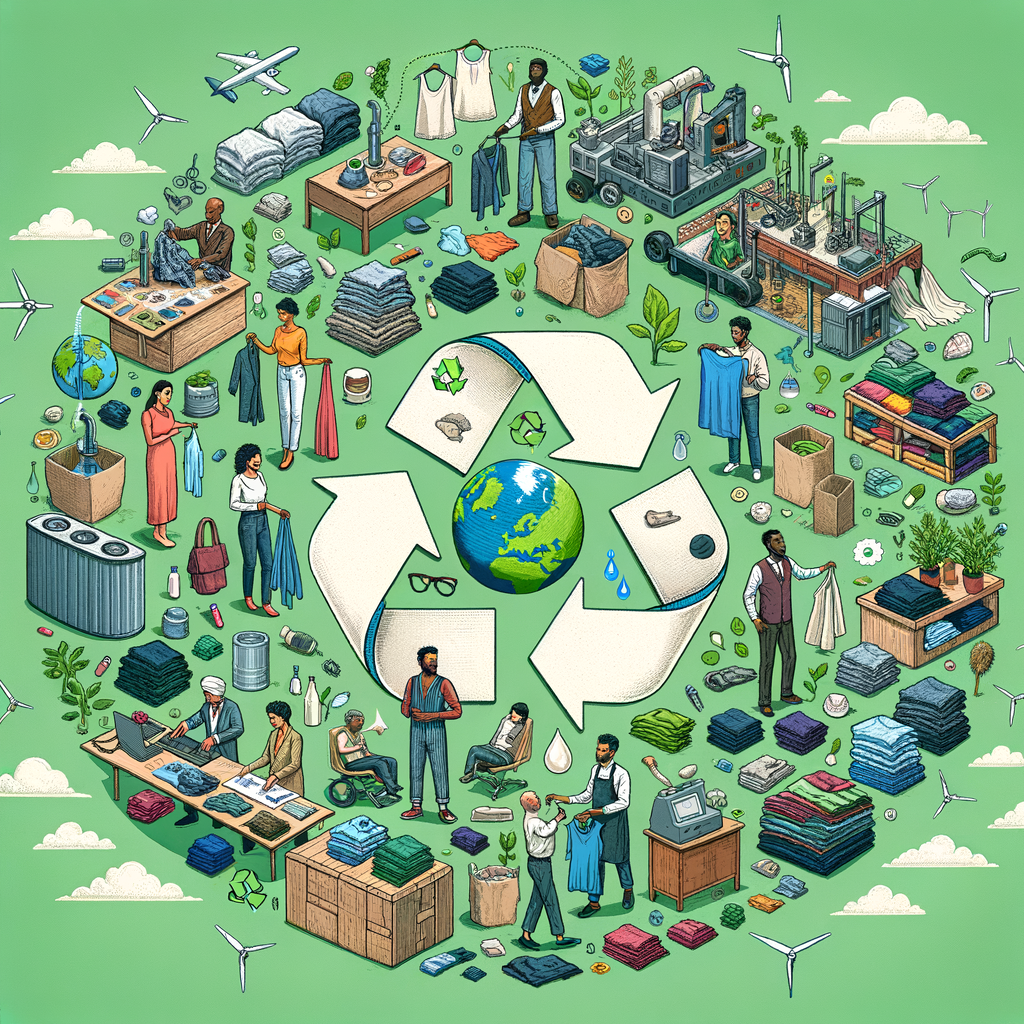Regenerating Fashion: The Circular Revolution


The fast fashion industry has come under intense scrutiny in recent years for its environmentally damaging practices and unsustainable levels of waste and pollution. With consumers becoming more aware of the impacts of fast fashion, there has been a growing movement towards more sustainable and ethical clothing production. Circular fashion represents an alternative approach that aims to radically transform the apparel industry into a closed-loop system.
Circular fashion seeks to redefine fashion as a service rather than simply the production and consumption of more and more physical clothing. The circular model is regenerative by design, using innovative new business models, production methods and technologies to eliminate textile waste. At its core, circular fashion aims to decouple economic growth from the use of natural resources and raw materials. It is often presented as an antidote to the wasteful, polluting practices of fast fashion.
But what exactly is circular fashion? What are the key principles and practices that define this new paradigm for the textile industry? In this comprehensive guide, we will examine what circular fashion entails, from sustainable design and production methods to innovative business models. Core concepts like "reduce, reuse, recycle" will be explored and contextualized for the apparel industry. Leading examples and innovative solutions driving this systemic shift will be analyzed as well.
Defining circular fashion is an important first step in catalyzing much-needed changes in the apparel sector. This article provides an in-depth look at what circular fashion means in theory and practice, setting the stage for the transformative solutions needed to create a truly sustainable fashion industry. The time has come to reimagine the broken fast fashion model and move towards a circular future for textiles and clothing.
Defining Circular Fashion
The concept of circular fashion represents a dramatic shift from the standard linear "take-make-dispose" model that has dominated the apparel industry. Circular fashion aims to decouple economic activity from the consumption of finite resources through innovative design, production, and business models. But what are the key principles and practices that comprise circular fashion?
Reduce, Reuse, Recycle
The core philosophy underpinning circular fashion systems is encapsulated in the “3Rs”: reduce, reuse, recycle. This involves:
Reducing the overall material inputs, waste, energy and pollution across the supply chain. Examples include using zero-waste pattern cutting techniques and minimalist packaging.
Reusing garments and materials multiple times through designing for durability, repair, refurbishment and re-commerce. Clothing rentals and resale platforms enable extended product lifecycles.
Recycling old clothing and textiles back into new fabrics and yarns through mechanical and chemical processes. Emerging technologies like fibre-to-fibre recycling help retain material quality.
Closed-Loop Systems
A key goal of the circular model is to capture all textiles at their end-of-use to feed back into the manufacturing loop and avoid any material ending up as waste. This relies on take-back programs, collection systems and reuse networks to recover clothing and recirculate fabrics and fibres.
Slower Material Loops
Circular systems emphasize slowing material loops by designing durable garments that can be worn for longer vs cheap fast fashion. Higher utilization through rentals and resale further prolongs product lifetimes.
Renewable Inputs
Transitioning to renewable, sustainably-sourced raw materials is a priority, including organic cotton, recycled PET and man-made cellulosics. Investments in agriculture help improve traceability and environmental practices.
Sustainable Practices in Textile Production
Implementing circularity in the fashion industry requires transforming production methods and supply chains to be more sustainable. This chapter explores key practices that are enabling a shift to closed-loop and environmentally regenerative models of textile manufacturing.
Use of Sustainable Materials
- Organic Cotton: Cotton grown without toxic pesticides and synthetic fertilizers has a lower environmental impact. Brands like Patagonia use 100% organic cotton.
- Recycled Polyester: PET plastic bottles can be recycled into polyester fiber for clothing. Adidas uses recycled polyester to make over 50% of its polyester apparel.
- Tencel: Made from sustainably-sourced wood pulp, Tencel lyocell fiber is biodegradable and produced in a closed-loop process. Stella McCartney and Levi’s use Tencel in select designs.
- Upcycled Materials: Waste fabrics and used garments are transformed into new textiles, diverting waste and reducing processing impacts. Brands like Evrnu and Renewcell specialize in textile upcycling.
Closed-Loop Manufacturing
- Zero Liquid Discharge: Closed-loop water systems filter and recycle water used in textile dyeing and treatment, reducing pollution and waste. Companies like Tejidos Royo implement this.
- Renewable Energy: On-site solar and wind energy helps factories power operations through clean sources vs fossil fuels. Adidas and H&M aim to fully transition to renewable electricity.
- Take-Back Programs: Brands such as H&M and Eileen Fisher have implemented initiatives to collect used clothing from customers to recycle into new products.
New Enabling Technologies
- Blockchain Tracking: Digital product passports on blockchain enable full transparency and traceability from raw materials to finished garment. Startups like Provenance are spearheading this.
- Chemical Recycling: Emerging processes like hydrothermal recycling allow polyester and nylon garments to be broken down into base chemicals for polymer remanufacturing. Worn Again and Evrnu are innovators.
Digital ID Tags: Radio frequency identification (RFID) tags and smart barcodes attached to clothing can store data and track items across supply chains and use cycles. C - ompanies like Avery Dennison provide these technologies.
The shift towards circularity in apparel manufacturing is being enabled by impact-driven brands embracing innovative new materials, processes, and technologies. However, scaling sustainable production remains an industry-wide challenge requiring transformation across all levels of the value chain. But the solutions explored in this chapter demonstrate the tangible pathways for creating closed-loop, waste-free fashion supply chains.
Circular Business Models
While sustainable design and manufacturing practices are central to circular fashion, new business models are also critical for scaling circularity. Innovative companies are pioneering alternative approaches that keep clothing in use longer and shift the basis of growth from production volumes to utilization rates.
Clothing Rentals
Rental models provide access to clothing through subscriptions or short-term loans. By extending use across multiple wearers, the overall production of new garments reduces. Rental platforms include:
- Rent the Runway - an online rental service offering designer fashion for special occasions or temporary use.
- Nuw - a Netflix-style monthly subscription allowing women to swap items from a rotating wardrobe.
- Designerex - a peer-to-peer rental marketplace enabling users to lend and borrow designer fashion.
Resale and Recommerce
The resale market turns closets into stockrooms to extract more value from clothing via reuse. Digital platforms like The RealReal and ThredUp have fueled growth in secondhand and vintage fashion. Brands are also launching their own resale shops, including Patagonia, Levi's, and Eileen Fisher.
Upcycling and Reconstruction
Upcycling repurposes discarded materials and clothing into new designs. Brands like Christopher Raeburn reconstruct military uniforms into outerwear while Nudie Jeans repairs damaged denim into upcycled lines. DIY fashion and customization also encourage unique remakes of existing garments.
Product-as-a-Service
Some brands are piloting performance-based models where customers pay for the service of clothing rather than owning the product. Dutch brand Mud Jeans leases jeans for a monthly fee while Filippa K offers subscriptions for its front-runner garments. These service models incentivize companies to design durable products that retain value over longer lifetimes.
The rise of access-based, peer-to-peer, and hybrid business models creates opportunities to decouple revenue from the extraction of natural resources. Prioritizing utilization over ownership is allowing forward-thinking brands to profit while reducing textile waste - aligning commercial success with sustainability.
Challenges and Opportunities Ahead
The transition towards a circular model entails seismic shifts throughout the apparel industry’s complex global supply chains. While the sustainable solutions profiled in this guide highlight the possibilities, scaling circularity faces an array of challenges. However, the opportunities for positive impact motivate continued innovation and collaboration.
Key Challenges
- Consumer Education: Mainstreaming circular practices requires educating consumers on new ownership models and sustainable materials. Most shoppers remain unfamiliar with circular fashion terminology and concepts.
- Scaling Infrastructure: Moving towards closed-loop recycling and renewable inputs involves major investments in collection-logistics and reprocessing facilities. Access to finance and policy incentives are needed.
- Industry Fragmentation: Fashion supply chains are vast networks spanning farms, factories, brands, retailers and vendors across multiple geographies. Aligning all actors is an organizational feat.
- Legacy Business Models: The profits of fashion companies remain tied to volume-driven sales of cheap, disposable fast fashion. Shifting entrenched business models is risk-laden.
- Policy and Regulation: Stronger sustainability regulations must mandate extended producer responsibility and enact standards around circularity. Government engagement lags behind.
Key Opportunities
- Consumer Values: Younger, environmentally-aware consumers are hungry for sustainable alternatives aligned with their values on waste and climate action.
Technological Advances: New technologies continue to enable greater transparency, recyclability, traceability and circularity across production and distribution networks. - Systemic Partnerships: Cross-industry collaborations can pool resources and coordinate efforts between brands, suppliers, retailers, recyclers and policymakers.
Creative Innovation: Circular solutions spark fresh creativity across design, marketing and communications in engaging consumers and stakeholders. - Regenerative Systems: Moving from just 'less bad' to truly regenerative models creates ripple effects improving lives, communities and the environment.
The path towards circularity is a complex systems-change process requiring collective action across sectors, industries and societies. However, the multifaceted opportunities for positive impact make this transition imperative for creating an ethical, waste-free fashion industry.
Conclusion
The fashion industry today stands at a critical juncture. The environmentally damaging practices of the linear fast fashion model have been thrust under the spotlight, scrutinized by consumers and regulators alike. With landfills overflowing with garment waste and microplastics from textile shedding polluting oceans, the need for radical change is clear.
Circular fashion represents that change. It entails a fundamental paradigm shift from the make-take-dispose system towards a closed-loop, regenerative model. As explored throughout this guide, circularity introduces innovative new ways of designing, producing, distributing and using clothing that eliminate the concept of waste.
Core principles like reduce, reuse and recycle are reimagined for the apparel industry through emerging solutions like take-back programs, product-as-a-service offerings, recommerce platforms and closed-loop manufacturing. Sustainable materials, traceability technologies and renewable energies further enable the transition.
While systemic change inevitably faces hurdles, the opportunities presented by circular fashion energize an industry-wide movement towards ethical and ecologically restorative practices. The solutions profiled throughout this article provide tangible steps for brands, retailers, manufacturers and policymakers to pave the path ahead.
By its very nature, fashion stirs the human imagination, pushing creativity and self-expression forward. With its regenerative possibilities, circular fashion seeks to rekindle that creative spirit - designing solutions that put people and the planet first. The goal is within reach to fundamentally redefine the fashion industry, leaving behind the harmful legacy of fast fashion and moving decisively towards a circular future.





-500x500.jpg)
-500x500.jpg)
-500x500.jpg)
-500x500.jpg)
-500x500.jpg)